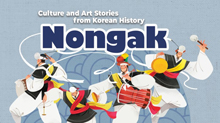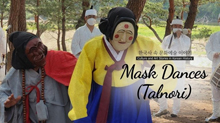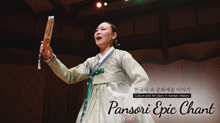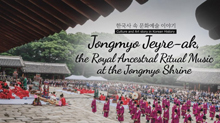The Story of Culture and Arts
- Image resource of Korean history
- Documents from History TextBooks
- Culture & Art Stories from Korean History
- Culture & Art Stories from Korean History - Korean
- National Institute of Korean History
- History net
- About the site
- Introduce
-
Numerous topics related to Korean culture and art are mentioned in middle and high school national history textbooks, but most of them are briefly described by era, making it difficult to understand their concepts, transition processes, and characteristics.
<Culture & Art Stories from Korean History> produces and provides video materials based on expert commentary on the flow, change process, characteristics and characteristics of each major topic in the field of culture and art in Korean history.

Scenario
Joy, anger, sorrow and pleasure.
Music, a power that can heal the hearts of people.
Music is always present at important ceremonies,and is the easiest and most powerful way to stir the emotions.
Music, the Way to Rule a Country
This has always been true, even in ancient times.
In that era, music was also used as a tool of statecraft.
To learn about music, we should begin by learning about the instruments that make music.
Let’s take a look at the musical instruments of Korea’s Three Kingdoms period.
One musical instrument that exists to this day is a 12-stringed Korean zither called in Korean “Gayageum,” meaning literally “zither of Gaya,” Gaya being an ancient state in the southern portion of the Korean Peninsula.
Theories on the origin of the 12-stringed Korean zither vary.
“Gayageum” means zither
of Gaya, Gaya being a state in the southern part of the Korean Peninsula
There are different theories on the origins
of the 12-stringed Korean zither known as the Gayageum
"The 12-stringed Korean zither was created
by King Gasil of Gaya, who modeled it
after a 13-stringed instrument from China.”
- History of the Three Kingdoms (Samguk sagi; 1145),
Book 32 (“Monograph on Music”)
However, the idea that the Gayageum was modeled after a Chinese instrument is found only in this record.
Actually, in the 3rd century, an instrument called the “Go” already existed in Korea.
A man named Ureuk composed 12 pieces of music on the order of Gaya’s King Gasil. These were pieces of folk music from the Nakdonggang River basin region.
When Gaya fell into decline, Ureuk and his student, Imun, sought asylum in neighboring Silla kingdom.
Ureuk became a great musician of Silla. He taught others how to play the 12-stringed Korean zither and spread its use in what is Tangeumdae Terrace of today’s Chungju.
In the late 19th century when “sanjo,” or solo instrumental music, was composed, improvements were made on the shape of the Korean zither.
That it was modeled after a Chinese instrument
is only mentioned in records
An instrument named the “Go” already existed
in Korea of the 3rd century
Ureuk composed 12 pieces of music
on the order of Gaya’s King Gasil
He composed folk music
from the Nakdonggang River basin region
Ureuk and his student, Imun,
sought asylum in the Silla kingdom
Ureuk became a great musician
of Silla
He spread the use of the 12-stringed Korean zither
in what is Tangeumdae Terrace of today’s Chungju
The shape of Gayageum, the 12-stringed Korean zither,
changed in the late 19th century
when “sanjo,” solo instrumental music, was composed
The Geomungo is an instrument created in the Goguryeo kingdom in the northern part of the Korean Peninsula. It represents the grand and powerful spirit of the northern peoples.
Differing from the 7-stringed Chinese zither, it its creation is credited to Wang San-ak, who was a Deputy Prime Minister of Goguryeo.
The use of the Geomungo also spread to the Silla kingdom, where Ok Bo-go composed 30 pieces of music for this 6-stringed zither. Over 187 pieces of music were composed during this period.
New varieties of the 6-stringed zither, some with more strings such as 7 or 10, also appeared at this time.
Geomungo, an instrument created
in the Goguryeo kingdom in the northern Korean Peninsula
Differs from the 7-stringed Chinese zither
Created by Wang San-ak,
a Deputy Prime Minister of Goguryeo
The use of the Geomungo also spread to the Silla kingdom
Ok Bo-go was a Silla composer who wrote some 30 pieces
of music for the 6-stringed zither
The Lotus Lantern Festival is a Buddhist event in which petitioners ask the Buddha for good fortune by lighting lanterns. It began during the period of Silla’s King Jinheung (reigned 540–576 CE) and was quite popular during Korea’s Goryeo Dynasty (918–1392).
The Lotus Lantern Festival was a national festival that was often performed upon a stage called a sandae. This leading Buddhist festival that represented the Goryeo Dynasty was held on the 15th of January, Hansik, and on the Buddha’s birthday in April.
Lotus Lantern Festival
- A Buddhist festival in which petitioners asked
the Buddha for good fortune by lighting lanterns
- Began in the period of Silla’s King Jinheung
and was popular during the Goryeo Dynasty
Lotus Lantern Festival
- Held on the 15th of January,
Hansik, and on the Buddha’s birthday in April
Palgwanhoe, or Festival of the Eight Vows, originated in India and spread to China, Silla, and Goryeo.
It was similar in nature to a harvest festival and included traditions that originated from Hwarang culture of the Silla kingdom as well as having characteristics of ancestor worship culture of the Goguryeo kingdom. It was an annual festival during the Goryeo period (918–1392).
India, China, Silla, Goryeo
Palgwanhoe, the Festival of the Eight Vows
- Originated in India and spread
to China, Silla and Goryeo
Palgwanhoe, or Festival of the Eight Vows
- Similar in nature to a harvest festival and included
traditions from the Hwarang culture of the Silla kingdom
as well as the characteristics of ancestor
worship culture of the Goguryeo kingdom
It was an annual festival during the Goryeo period (918–1392)
Hyangak, native Korean court music, was played together with aak, classical court music, during state ancestral rites of the Goryeo Dynasty. Some was performed along with music from China’s Tang Dynasty at royal court events.
The 5 types of Chinese court banquet dance—the Peach Offering Dance, Long-Live-the-King, Dance of the Five Fairies, Ball-Throwing Dance, and Dance of the Lotus Stand—were also performed during the Joseon Dynasty and are still exist today.
Saak, which was imported to Korea from the Song Dynasty, was the musical recitation of poetry. It was popular during the Goryeo period, and the “Monograph on Music” from the History of Goryeo (Goryeosa; 1451) records that 43 pieces of music were preserved.
However, today only two, “Pacing the Void" and "Spring in Loyang," are extant.
Ancestral rites music was imported to Korea from the Song China during the Goryeo period.
It is called the Daeseong version of aak classical court music and was imported in the year 1116 (11th year of King Yejong of Goryeo).
Aak classical court music was played by pairing a word to each note with a homographic melody that clearly conveyed the lyrics.
Hyangak, Native Korean Court Music
- Performed with aak, classical court music,
during state ancestral rites of the Goryeo Dynasty
- Some was performed along with music
from the Tang Dynasty at royal court events
There were five types of Chinese court banquet dance:
Peach Offering Dance, Long-Live-the-King,
Dance of the Five Fairies, Ball-Throwing Dance, and
Dance of the Lotus Stand
Saak, a musical recitation of poetry
imported from Song China,
was popular in the Goryeo period
The “Monograph on Music” of the History of Goryeo (Goryeosa) records that 43 pieces of music had been preserved, but today
only “Pacing the Void” and “Spring in Loyang”
are extant
The Daeseong variety of aak classical court music
- Ancestral rites music imported
from Song China during the Goryeo Dynasty
- Imported in the year 1116 (11th year of Goryeo’s King Yejong)
Characteristics of aak classical court music
imported during the Goryeo Dynasty
- Performed with a word paired to each note
- Homographic melody that clearly conveyed the lyrics
Jahadong
My home is in Jahadong on Mt Song
It is called Junghwadang,
And mixes with the clouds and fog
Today, I heard glad tidings
that the elders have gathered
so I am offering a glass of Jangsangju drink
[…]
Junghwadang in Jahadong
As the music plays, the guests well-seated
are the elders of the Three Han States
Flowers in their snowy hair,
their hands grasp golden goblets
as they offer up mutual toasts
Not even the Taoist immortals
of the Isle of Eternal Youth have it better
“Jahadong" from History of Goryeo
What you’ve just read are the lyrics of a song titled “Jahadong” written by Chae Hong-cheol, a composer and patron of music of the Goryeo Dynasty.
Music had much to do with the establishment of the Joseon Dynasty, and Jeong Do-jeon was at the center of it all.
In “Statutes for the Governance of Joseon,” Jeong emphasized that "The country should be governed with benevolence, and it is only right that one should maintain the way of benevolence in your person."
He made various efforts to create state ceremonies for the Joseon Dynasty.
Music had much to do with the establishment
of the Joseon Dynasty through the efforts of Jeong Do-jeon (1342–1398)
“The country should be governed
with benevolence, and it is only right that one
should maintain the way of benevolence in your person”
Jeong Do-jeon’s words from his “Statutes
for the Governance of Joseon”
Jeong Do-jeon made various efforts to create
state ceremonies for the Joseon Dynasty
Official ceremonies of the Joseon Dynasty may be divided into 5 types; Auspicious ceremonies, Felicitous ceremonies, Ceremonies for receiving state guests, Ceremonies for military reviews, and Mourning ceremonies.
State ceremonies with music continued into the late Joseon Dynasty.
King Sejong (reigned 1418–1450) not only created the Hunmin jeongeum (the Korean script, now known as Hangeul), but also redefined and composed aak, classical court music.
State ceremonies of the Joseon Dynasty can be categorized into 5 types:
Auspicious ceremonies,
Felicitous ceremonies,
Ceremonies for receiving state guests,
Ceremonies for military review,
Mourning ceremonies
King Sejong created the Hunmin jeongeum (the Korean script),
and organized aak, classical court music
King Sejong created Jeongganbo, a mensural notation system, reorganized aak classical court music, and invented the Korean 16-stone chime, which became the standard aak instrument.
The “Annals of King Sejong Music Notation,” published in King Sejong’s time, is Korea’s oldest existing score.
King Sejong’s achievements
- Created Jeongganbo, a mensural notation system
- Reorganized aak classical court music
and invented the Korean 16-stone chime,
which became the standard aak instrument
The ”Annals of King Sejong Music Notation,”
from this time is Korea’s oldest existing musical score
King Sejong is considered to have contributed much to the history of music in Korea. King Sejong made continuous efforts in organizing national music.
King Sejong not only patronzied Park Yeon, he also composed “Joy of the People,” which was used in state ceremonies, and “Dance for Preserving the Peace” and “Founding a Great Dynasty,” used in official court ceremonies. Later, this music became the Royal Ancestral Ritual Music at the Jongmyo Shrine.
King Sejong supported Park Yeon and composed
“Joy of the People,” which was used in state ceremonies
He also composed “Dance for Preserving the Peace”
and “Founding a Great Dynasty,” music
used in official court ceremonies
This music later became Royal Ancestral
Ritual Music at the Jongmyo Shrine
King Seongjong (reigned 1469–1494) had law books compiled along with books on state rituals.
The fact that Seong Hyeon, Minister of Rites at the time, compiled the Canon of Music (Akhak gwebeom), the premier music book of the Joseon Dynasty, shows that the Joseon Dynasty’s political culture stressed the importance of ritual courtesy and music.
King Seongjong had law books compiled
along with booka on state rituals
Seong Hyeon, Minister of Rites at the time,
compiled the Canon of Music,
the premier music book of the Joseon Dynasty
This demonstrates that the Joseon Dynasty’s political culture stressed the importance of ritual courtesy and music
The efforts to reorganize national music continued even after the reigns of Kings Sejong and Seongjong. The reigns of King Yeongjo (1724–1776) and King Jeongjo (1776–1800) were called the golden age of culture, and music advanced exponentially during the time.
King Yeongjo published music and law books, such as Introductory Remarks on National Rituals (Gukjosok oryeui), Reference Compilation of Documents on Korea (Dongguk munheon bigo), Study of Music (Akko), and Supplement to the National Code (Sokdaejeon).
Behind King Yeongjo’s achievements in cultural prosperity was a man named Yi Yeon-deok.
King Yeongjo established the Temporary Bureau of Musical Instruments and sent an official to Beijing to learn how to make a mouth organ with 17 bamboo pipes.
Yi Yeon-deok, who was appointed as the Director of Musical Instrument Manufacturing, created instruments for court music and organized aak court music.
King Yeongjo’s achievements
- Published books on music and law,
such as Introductory Remarks on National Rituals,
Reference Compilation of Documents on Korea,
Study of Music, and Supplement to the National Code
Behind King Yeongjo’s achievements in cultural prosperity
was a man named Yi Yeon-deok
King Yeongjo’s achievements
- Established Temporary Bureau of Musical Instruments
- Sent an official to Beijing to learn how to make
a mouth organ with 17 bamboo pipes
Yi Yeon-deok, who was appointed
as the Director of Musical Instrument Manufacturing,
created instruments for court music
and organized aak court music
King Jeongjo recognized the importance of music and ceremony.
After King Jeongjo ascended the throne, he established the Royal Archives (Gyujanggak) and endowed it with court musical instruments, such as bells, chimes, 7-stringed zithers and 25-stringed zithers. He placed great emphasis on music.
He stressed education in music and poetry to produce vassals well-versed in these arts.
To King Jeongjo, music was more than something to enjoy;
it was something to study and cultivate, and so he made efforts to train people in the arts of ceremonial courtesy and music.
King Jeongjo recognized the importance of
both ritual ceremony and music
King Jeongjo’s achievements
- Established the Royal Archives
and specially gifted it with court musical instruments,
such as bells, chimes, 7-stringed zithers
and 25-stringed zithers
Placed much emphasis on music
King Jeongjo’s achievements
- Fostered education in music and poetry to produce vassals
well-versed in these arts
What meaning did music hold for King Jeongjo?
Something to practice and cultivate rather than merely enjoying
King Jeongjo made efforts to produce vassals
well-versed in music and ceremonial courtesy
Among the populace, lyrical songs were popular especially among the bureaucratic middle class.
String ensemble music was popular among the literati and instrumental musicians.
Also, playing the 6-stringed zither was popular among the literati of the Joseon period.
The string Yeongsan hoesang instrumental musical repetoire was popular, with the 6-stringed zither, often play by the literati of the Joseon period,at its center.
Lyrical songs were popular especially among
the bureaucratic middle class
String ensemble music was popular among
the literati and instrumental musicians
Playing the 6-stringed zither was popular among
the literati of the Joseon period
The string Yeongsan hoesang instrumental music
Was a popular musical form, with the 6-stringed zither, often played by literati
of the Joseon Dynasty,
at its center
Pansori is an artistic musical genre from the late Joseon period.
The first recorded pansori is the “Narrative Song of Chunhyang” in 200 words from the Manhwajip, the collected works of Yu Jin-han(whose penname was Manhwa).Shin Jae-hyo, a pansori theorist, educator, and musical sponsor, is credited with reviving pansori in the Joseon period.
In 2003, Pansori was inscribed on the list of UNESCO Masterpieces of the Oral and Intangible Heritage of Humanity.
Pansori, an artistic musical genre
from the late Joseon Dynasty
Pan, meaning a gathering of many people
Sori, meaning songs
Sorikkun, a single performer who plays many roles
The first record of a pansori is the “Narrative Song
Chunhyang” in 200 words from the Manhwajip.
the collected works of Yu Jin-han
Shin Jae-hyo (1812-1884)
- A pansori theorist, educator, and musical sponsor
In 2003, pansori was inscribed on the list of UNESCO
Masterpieces of the Oral
and Intangible Heritage of Humanity
12-stringed zither of Gaya,6-stringed Korean zither of Goguryeo, Lotus Lantern Festival and Festival of Eight Vows, ancestral rites from the Goguryeo Dynasty.
The Joseon Dynasty, the country of courtesy and music.
King Sejong, the king who organized ceremonial music and created music unique to Korea.
Pansori from the late Joseon Dynasty that reflects joy and sorrow as well as satire.
The long history of Korea’s traditional musical arts reflects the spirit of the Korean people, who have always pursued and cultivated music and courtesy.
12-stringed zither of Gaya
6-stringed Korean zither of Goguryeo
Lotus Lantern Festival and Festival of Eight Vows,
ancestral rites from the Goguryeo Dynasty
Joseon Dynasty, the country of courtesy and music
King Sejong, the king who organized
ceremonial music and created music unique to Korea
Pansori from the late Joseon Dynasty
that reflects joy and sorrow as well as satire.
The long history of Korea’s traditional musical arts reflects the spirit of the Korean people, who have always pursued and cultivated music and courtesy.
-------------------------------------
Script Advisor: Song Ji-won
Scenario Composition: Ahn Hyeon-jin, Kim Min-sang
Voice Actor: Oh Su-gyeong
MC: Ju Hye-bin, Hwang Ba-eul
Illustrator: Lee Gwang-il
Research Material Support: National Museum of Korea, Gyeongju National Museum, Cultural Heritage Administration, Hanseong Baekje Museum, E-Museum National Gugak Center
Directors: Kim Hyeong-woo, Lee Hyeok-roh, Lee Yeon-sik
Planning and Production: Arirang TV Media







